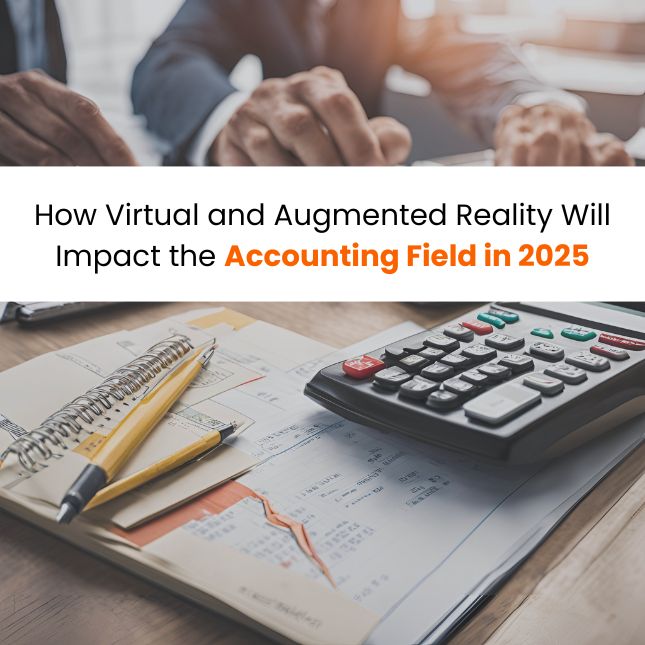OVERVIEW:
Virtual and augmented reality in accounting field can play a very significant role; these technologies help professionals visualize and interact with financial data in a unique manner. Virtual reality lets the user interact with computerized simulations, and VR makes it conveniently easy for accountants to identify or analyze trends, issues, etc. Whereas augmented reality includes covering all the digital elements in the real world through devices such as smartphones and augmented reality (AR) glasses. These technologies are forecasted to make accounting practices more accurate and efficient in 2025. The following are the impacts expected from them:
ENHANCED DATA VISUALIZATION:
Virtual and augmented reality in accounting field can enhance data visualization through 3D or immersive formats. This will help accountants better understand complex financial statements or data. By incorporating virtual and augmented reality into accounting practices, accountants can make intuitive analyses. An example of implementing such technology in the accounting sector could be an accountant having a virtual and visualized space where all the financial data or reports are displayed all around them, allowing them to get a deeper and more accurate understanding of the data.
VIRTUAL COLLABORATION:
Incorporating virtual reality in accounting field practices allows virtual collaboration to take place amongst fellows, colleagues, partners, etc. Through virtual collaborations, colleagues can attend meetings, discussions, etc., online through various forums. They can also share financial reports, data, or analysis during these meetings. This not only is time-effective and cuts the cost of traveling but also is effective for teamwork and better collaborative understanding.
TRAINING AND DEVELOPMENT:
Virtual reality in the accounting field also helps firms, institutes, or professionals in giving training and webinars online. They can offer their training sessions or webinars virtually through many online platforms, rather than going for traditional in-person classes. Virtual training also provides them with interactive simulations creating real-life scenarios and practicing skills (auditing, taxation, financial reporting, etc.). Giving real-life scenario-based questions is more effective and hence results in better understanding and problem-solving skills. Students or trainees prefer virtual training and development programs as they are more flexible, feasible, time-effective, etc.
AUTOMATION OF ROUTINE TASKS:
Virtual and augmented reality in accounting field practices is used in many ways, but automation of routine tasks makes life much easier for accountants. Virtual and augmented reality may, however, be known for interaction and visualization, but automation or AI also covers a very broad range of them. Automation makes daily routine tasks vanish from an accountant’s life, while AI is responsible for routine accounting field tasks like data entry, report generation, etc. Accountants can concentrate on more complex problems, strategy planning, or decision-making processes. This way, the workflow is more effective and efficient and lessens the workload on accountants, allowing them to be more productive during strategic work.
CLIENT INTERACTION AND PRESENTATION:
Virtual and augmented reality in accounting field practices is very effective for interactive and productive client discussions or presentations. Accountants can virtually present their ideas and strategies by sharing reports or data during the meeting. A virtual reality environment during the meeting allows the clients to ‘walk through’ the financial data or reports, understanding their key metrics, etc. The overall experience of client interaction is quite engaging and client-friendly and gives clarity to the financial standing of the firm, organization, or partner.
Moreover, with the help of AR and VR analyzing the future strategies becomes easier as it helps to take the decision effectively by visualizing the future unforeseen circumstances to choose the low risk strategy through analyzing the financials and other factors.

REMOTE AUDITING AND REVIEW:
Augmented reality in the accounting field is also very helpful for remote auditors/auditing. Auditors do not need to go fully on-site; rather, they can work from anywhere virtually. Auditors can easily inspect documents, transactions, or even physical assets remotely and provide insights or thorough reviews based on the inspection. Augmented realities or technologies also allow the auditor to highlight the key information while inspecting or analyzing large financial data. This additional effect makes their work more accurate, presentable, and efficient and reduces errors. Augmented reality allows auditors to take over remote work opportunities and work efficiently with the modern technological touch.
IMPROVED CLIENT SERVICES:
Another big accomplishment of augmented reality in the accounting sector is that it not only benefits the accountants or organizations only, but also benefits the customers as well. Augmented reality lets customers or stakeholders know the real-time financial position of the organization through a single click. Customers can simply scan the documents with their mobile phones and avail themselves of the information regarding the financial position of the firm. This practice builds trust between the client and the organization by showcasing transparency and credibility, which eventually leads to a better and stronger relationship with the clients.
DECISION-MAKING SUPPORT:
Good and effective decision-making is very important in any business; accountants, especially those making decisions based on financial considerations, need to be extra careful. However, both virtual and augmented reality in accounting field play a vital role in improving the decision-making process globally. It helps them to visualize the financial forecasts, analyze and identify the impacts of various decisions on future business plans, analyze risk factors and ways to avoid them, etc. With all of these factors, accountants can analyze the situation, do their research, and then finally make an informed and effective decision. Along with that, with the help of augmented and virtual realities, you can also communicate, advise, and discuss the situation with clients or other stakeholders.
CONCLUSION:
It will be safe to say that in 2025, virtual reality and augmented reality in the accounting field will take over the whole sector. These technologies can completely alter the traditional way of accounting (spreadsheets and numbers) into an interactive, data-driven, and efficient field. It not only allows time effectiveness, accuracy, and transparency but also contributes to improving customer relations and efficient decision-making. The impact that might be seen is that the routine accounting tasks will be automated, virtual collaborations, enhanced data visualization, virtual client interactions, etc. Hence, it is forecasted that a huge positive shift in the rise of these technologies could be seen in the accounting sector in 2025.





